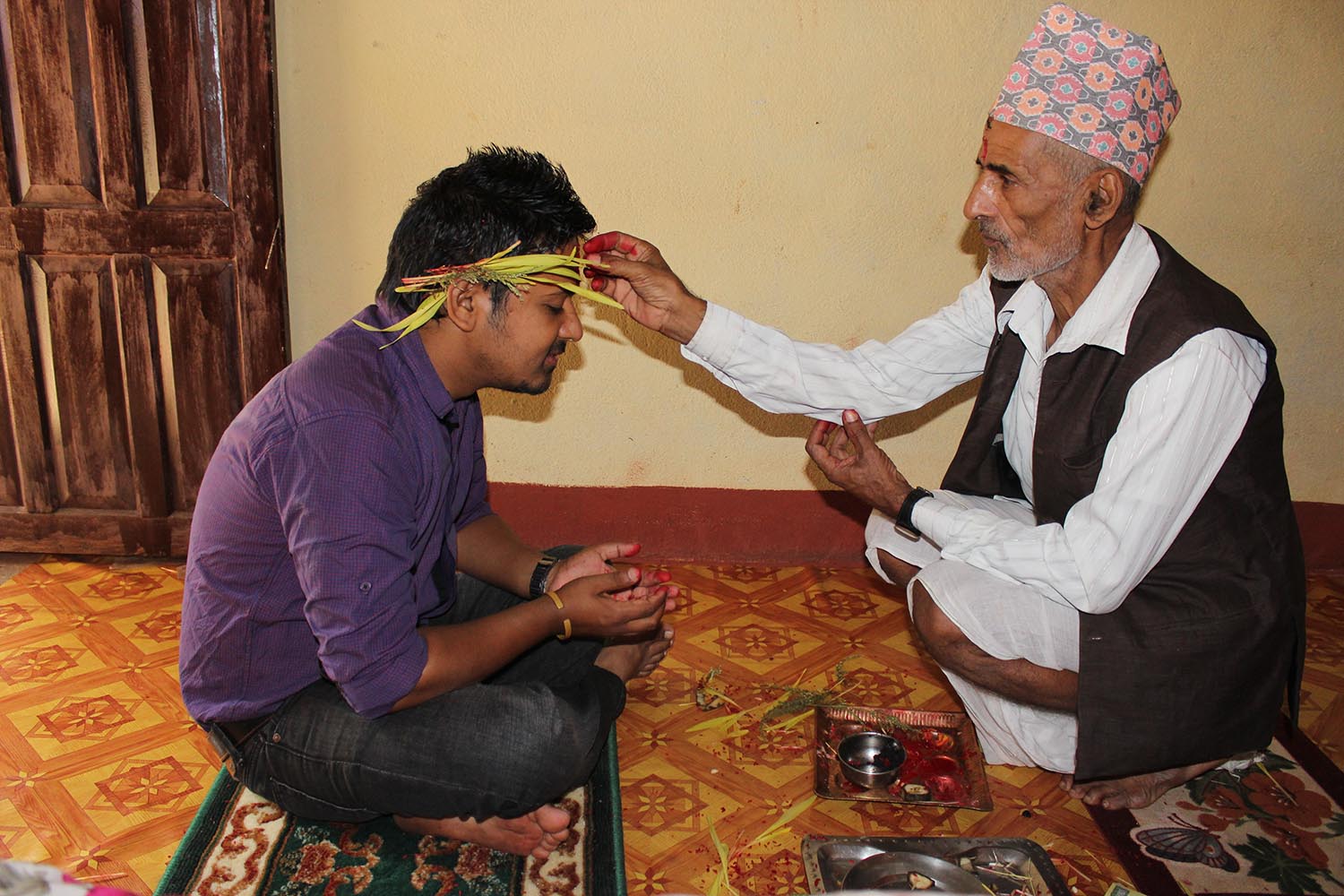Culture & Lifestyle
We’ve all heard Dashain mantras, but do we know what they mean?
From ‘Ayu Drona Sute’ to ‘Jayanti, Mangala, Kali, Bhadrakali, Kapalini’, the mantras embody values of strength, wisdom, unity, and compassion.
Reeva Khanal
Among the many joys of the upcoming Dashain festival, one is when elders place tika on the foreheads of the younger ones, accompanied by the chanting of sacred mantras. This ritual goes beyond the symbolic red mark; it is a moment of blessing, a prayer that carries wishes for long life, prosperity, courage, and wisdom.
The words spoken may seem ancient, but their resonance is timeless, weaving together generations through faith and tradition. In many homes, these mantras are softly uttered, their meanings often left unexplained, yet they continue to embody the values and hopes that have shaped Nepali society for centuries. It is within these chants that the heart of Dashain lives—where spirituality meets familial love in the purest form.
According to scholar Kiran Pokharel, who studied Karmakanda at the National Sanskrit University, the blessings men receive during tika rituals come from legendary figures and divine traits. Elders begin by wishing longevity like Ashwatthama, the immortal son of Dronacharya, symbolising an enduring life rooted in both vitality and spirit. Prosperity and dignity are invoked through King Dasharatha of Ayodhya, remembered not only for his wealth but also for his honourable rule. The triumphs of Rama, his son, embody the destruction of enemies—external and internal—through dharma, encouraging the younger generation to conquer fear, ego, and ignorance.
King Nahusha’s rise to the throne of Indra symbolises abundance and opportunity, while the swift energy of the wind represents adaptability and dynamism. Duryodhana, though controversial, is remembered for his loyalty and sense of honour, reminding men to hold fast to their self-respect even in adversity, Pokharel explains.
He further adds that qualities of bravery, strength, generosity, wisdom, and fame complete the cycle of blessings. From Bhishma, the son of Shantanu, comes the courage to endure and uphold values, while Balarama, wielder of the plough, represents physical might and rootedness in one’s livelihood.
Karna, son of Kunti, embodies generosity and compassion, urging selflessness in giving. Vidura, the wisest counsellor, is evoked for clarity of mind and moral judgement. Finally, Narayana, the preserver, signifies enduring fame grounded not in fleeting popularity but in righteousness and good deeds.
Together, Pokharel notes, these verses create a vision of manhood that combines strength with wisdom, prosperity with humility, and courage with compassion—ensuring that younger generations are guided by the ideals of epic heroes as they step into life’s responsibilities.
Pokharel also points to the verses dedicated to women. Here, he says, “the blessings recited for women during tika rituals highlight their embodiment of divine power.” The mantra begins with, “I salute you, known as Jayanti, Mangala, Kali, Bhadrakali, Kapalini, Durga, Kshama, Shiva, Dhatri, Svaha, and Svadha,” invoking multiple divine aspects of Goddess Durga. Each name carries its own significance—Jayanti (victorious), Mangala (auspicious), Kali and Bhadrakali (fierce protectors), Kapalini (symbolising liberation), Durga (invincible), Kshama (forgiveness), Shiva (benevolent), Dhatri (nurturer), and Svaha and Svadha (linked to sacrificial offerings).
Pokharel explains that through this recitation, women are blessed as embodiments of these divine attributes, carrying the strength, compassion, and protective energy of the goddess herself.
He further elaborates that subsequent lines emphasise the omnipresence and transformative power of the feminine divine. “Victory to you, Goddess Chamunda! Victory to you, reliever of the sufferings of all beings,” projects women as protectors and nurturers, capable of dispelling sorrow and fear. “O Kalaratri! Salutations to you,” invokes fearlessness and the ability to overcome darkness and ignorance.
The blessing continues with, “O auspicious one, auspicious in all auspiciousness, fulfiller of all purposes,” emphasising prosperity, wellbeing, and harmony. Finally, “O Gauri Narayani, with three eyes, protector of all, I bow to you,” draws on the goddess’s wisdom and foresight, inspiring women to nurture while safeguarding their families and communities.

For Pokharel, these mantras do more than honour women—they elevate them to cosmic significance, reflecting both fearsome and nurturing aspects of the divine feminine.
Dr Bhim Khatiwada, former rector of Nepal Sanskrit University, reflects on Dashain as a festival that goes beyond religion. For him, it stands as a celebration of Nepal’s multicultural and multilingual heritage, uniting people across faiths and traditions. He stresses that while its roots lie in Hindu practice, its spirit belongs to everyone. The long holidays and gatherings, he observes, create space for families to reunite and communities to bond, giving Dashain a unique atmosphere that sets it apart from other festivals.
Even for those living abroad, the festival carries a powerful reminder of home—of returning to one’s roots, one’s family, and one’s nation—ultimately reinforcing unity and collective belonging.
Khatiwada further explains that the rituals, including the Tika and recitations from the Ramayana, carry profound symbolic meaning. They commemorate Ram’s victory, representing the triumph of truth over injustice and good over evil. In his view, Dashain is a festival of peace, prosperity, and unity, a celebration that encourages society to move forward in harmony. It highlights the essence of communal togetherness, bridging diverse traditions, languages, and cultures within Nepal, and reflecting the spirit of a truly united nation.
He also adds that Dashain carries a deeply social dimension. Beyond its religious and cultural significance, the festival celebrates the triumph of truth and righteousness, reminding society that good always prevails. Taking blessings from elders—those we respect—through tika is a practice that reinforces social bonds, gratitude, and communal values. While the ways we celebrate may have evolved in today’s society, Khatiwada emphasises that these blessings remain timeless and precious, carrying the hopes, virtues, and guidance of one generation to the next.
In an explanation shared by Hamro Itihas on Instagram, the verse from the ritual blessing is unpacked into wishes that draw from the epics. For instance, the line “Ayu Drona sute” conveys the wish—may you become immortal like Ashwatthama, the son of Dronacharya. Similarly, “Sriyem Dasarathae” translates to may your prestige prosper like that of King Dasaratha of Ayodhya, while “Satru Chheyam Raghabe” invokes Lord Ram, blessing the child with the strength to wipe out enemies as he once did.
The blessing continues with equally powerful wishes rooted in mythology. “Aishoryai Nahushe” expresses the hope for material well-being to thrive like King Nahush’s, while “Gatischa Pawane” prays for speed that rivals the wind itself. “Manancha Duryodhane” recalls the respect people once gave to the Prince Duryodhan of Hastinapur, and “Sourya Shanta nabe” draws on the valour of Bhishma Pitamah, the son of Santanu.
Strength is invoked with “Balam Haldhare”—a wish to be as mighty as Balaram, Lord Krishna’s elder brother—and truthfulness with “Satyanta Kunti Sute”, which refers to Yudhishthir, the son of Kunti, who never lied. The verse then elevates wisdom with “Bigyani Bidure Bhawati Bhabatam”—a prayer to be as wise as Vidur—and finally concludes with “Kritischha Narayane”, a blessing for glory to flourish like that of Lord Vishnu.
The tika, the mantras, and the gatherings intertwine spiritual devotion with cultural identity, guiding younger generations to embody virtues of courage, wisdom, and compassion. Whether in homes across Nepal or through virtual connections abroad, Dashain continues to affirm the enduring values of peace, prosperity, and togetherness, ensuring that the spirit of the festival remains as vibrant and meaningful as ever.




 16.63°C Kathmandu
16.63°C Kathmandu















